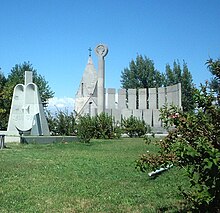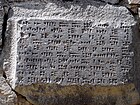Yerablur
| Yerablur | |
|---|---|
Եռաբլուր | |
| Government of Armenia | |
 | |
| For those who sacrificed their lives for the independence and freedom of Armenia and Artsakh | |
| Established | May 26, 1992 |
| Location | 40°09′36″N 44°27′15″E / 40.159975°N 44.454214°E |
Yerablur (Armenian: Եռաբլուր, lit. 'based on three hills') or Yerablur Military Pantheon is a military cemetery located on a hilltop in the outskirts of Yerevan, Armenia. Since 1988, Yerablur has become the burial place of Armenian soldiers who died during the Nagorno-Karabakh conflict.
History[edit]
On 26 May 1992, the status of the cemetery was approved by the order of the Government of Armenia.[1]
Layout[edit]
It is located in the western part of Yerevan, on the Yerablur hill, to the right of the Yerevan-Etchmiadzin highway. The height of the hill is 951 m, and the area of the pantheon is 19.22 ha. On the left side of the entrance to Yerablur is the chapel, in front of which is the Museum of the Fallen Freedom Fighters, next to it is the monument commemorating the 39 soldiers of the Armenian Secret Army for the Liberation of Armenia, further is the monument to the missing Freedom Fighters. In Yerablur are the graves of the National Heroes of Armenia Vazgen Sargsyan, Jivan Abrahamyan, Monte Melkonyan, the soldiers of Nagorno-Karabakh war many other notable Armenians. The complex is guarded by the military guard service of the pantheon. Since 1995, the Committee of the Parents of the Fallen Freedom Fighters of the Yerablur Military Pantheon has been functioning.[1]
Notable burials[edit]

Many famous Armenian heroes are buried in this military cemetery, including:
- Vardan Stepanyan (1992)
- Gurbanmurad Nepesov (1992)[2][3][4][5]
- Monte Melkonian (1993)
- Garo Kahkejian (1993)
- Shahen Meghrian (1993)
- Sose Mayrig (died in 1952, reburied at Yerablur in 1998)
- Vazgen Sargsyan (1999)
- Andranik (died in 1927, reburied at Yerablur in 2000)[6][7]
- Gurgen Margaryan (2004)
- Sebouh Nersesian (died in 1940, reburied at Yerablur in 2014)[8][9]
- Gourgen Yanikian (died in 1984, reburied in 2019)[10]
All memorials from Yerablur military cemetery are available for viewing on hush.am genealogical website.
Architecture[edit]
The authors of the plan and architectural solutions of the plan of Yerablur Pantheon are the architects of A. Mkhitaryan's Studio. The construction and construction works were carried out by "Hayaviashin" company. The tombstones are mainly made of basalt.
Gallery[edit]
-
The main entrance
-
Monte Melkonian
-
Garo Kahkejian
-
Sose Mayrig
-
Vazgen Sargsyan
-
Andranik
-
Gurgen Margaryan
-
Yerablur in 2021
See also[edit]
References[edit]
- ^ a b "Եռաբլուր պանթեոն". ekm.am (in Armenian).
- ^ a Turkmen volunteer in the First Nagorno-Karabakh War on the Armenian side and the only Muslim buried in the cemetery.
- ^ Panduxt (1 June 2014). "Կուրբանմուրադ Նեֆեսովի մասին հոդվածը "Ոսկանապատ" վերլուծաբանական կենտրոնի կայքում". Archived from the original on 18 February 2018. Retrieved 16 May 2022.
- ^ Barseğyan, Aykuhi (12 November 2013). ""Արյունով ազատագրած հողը չենք թողնի տան ուրիշին". ազատամարտիկ". Archived from the original on 18 February 2018. Retrieved 16 May 2022.
- ^ Qazaryan, Lusin (21 May 2014). "Եռաբլուրում թաղված միակ մահմեդականը.ցնցող պատմություն". Henaran.am (in Armenian). Archived from the original on 24 May 2014. Retrieved 16 May 2022.
- ^ "Gen. Andranik's Remains to Be Buried in Armenia". Asbarez. 9 February 2000. Retrieved 28 September 2013.
- ^ Khanbabyan, Armen (22 February 2000). Перезахоронен прах героя [The remains of the hero were reburied]. Nezavisimaya Gazeta (in Russian). Retrieved 6 September 2013.
- ^ "National Hero Gen. Sebouh Reinterred at Yerablur". Asbarez. 20 November 2014.
- ^ "Commander Sepuh's remains brought to Yerablur Military pantheon". PanARMENIAN.Net. 20 November 2014.
- ^ "Reburial of Gourgen Yanikiyan's remains in Yerevan angers Ankara". armradio.am. Public Radio of Armenia. 7 May 2019. Archived from the original on 13 November 2019.










